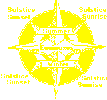Beyond Stonehenge, Geerald S. Hawkins, Harper and Row, 1973. Hawkins tries his methods on some Westrn hemispheric mysteries -- and fails to find star correlations for the very mysterious long lines and figures on the stony desert of Nasca, Peru. A much clearer treatment of methods is set forth in the Appendix here.
TWO NEGATIVE EXAMPLES
These negatives are all drawn from a great stack of material that the U.S. Park Service in Bighorn National Forest gives to researchers. The Park Services does not have any of Dr. Eddy's writings.
Allan G. Fries "Vision Quests at the Bighorn Medicine Wheel and its Date of Construction," same issue of Archaeoastronomy as the Robinson article, pp 20-23. No affiliation is given for Fries, just an address in Seattle. In my opinion the article represents a sort of "science racism". He makes some date calcs of his own that rest on nonsense (not much detail is given), he obviously knows nothing of how it is done. He uses this nonsense to accuse Eddy of errors in dating. Too, he says "In 1978, I examined the cairns and evaluated their suitability for protecting a person spending a night in the open. Cairns A, D and E [the sunsight] are only the size of campfire rings, and a few inches high."
Well, it was 1978 I spent the night up there to see the solstice sunrise, and he
wasn't there. Assuming it was some other time, in '78, though, I spent the night in my sleeping bag inside the sunsight cairn E. Its walls were about 20" above the general ground level, but within the U-shaped rock walls was a lower floor. It was long enough to stretch out in my sleeping bag, my toes to the hub at the U's opening. The walls provided good protection from the fierce night winds. Either he was lying or the Little People snuck out of their holes up there and filled it in, after I was there.
An even longer typescript, also distributed by the U.S. Forest Service in a Bighorn Wheel info package is "Sun Dances, Thirst Dances and Medicine Wheels: A Search for Alternative Hypotheses," by Michael Wilson, an anthro from University of Calgary, prepared for what appears to be private publication by his department. Wilson is peeved because in 1973 he excavated a bit of the Bighorn wheel's flooring and concluded the spokes and rim were built later than the cairns (as earlier excavators also had concluded) and he told Eddy about it, but Eddy didn't credit him.
He has a pet theory of his own, and his idea of science for it is to show a whole bunch of graphs of current rainfalls where wheels are located on the high plains. (This is supposed to prove there was too much rain up there for it to be used as a solstice sunrise observatory.) Of course (a) Hundreds and thousands of years ago, rainfall was different. (b) Uses made of these wheel sites by later Indians may have varied quite widely; obviously their use to observe dawn rising stars thousands of years ago could only happen during the short period those stars do rise heliacally there. After that, the mysterious structures were perhaps visited by different people for such purposes as vision quests.
I don't really know what Cree Sun Dances are all about -- Wilson claims they are rain dances and unconcerned with the sun. Maybe so, but that can't be proved from the words used to refer to them. Cree language has a lot in common with Anishnabeg (we all started the migration together, they went north). The several different words for it that he was told seem to express the fact that dancers in this ceremony do not drink any water (as well as fasting) as long as it lasts; they may or may not be trying to call down rain, as is done in public dances in southwestern pueblos. Actually, most native people didn't and do not live on the inhospitable high plains,where perhaps some kind of rain dance might make sense, but rather in the lake-and-forest region north and east of the Rockies and high plains.
Wilson also feels the posthole in bedrock below the Bighorn hub cairn isn't a posthole at all -- Grey and others in 1958 were just wrong about what they saw. He says: "An extremely important element in the (observatory) hypothesis is the supposed presence of a central pole," he writes. He fumes at journalists who filmed the site with their own pole stuck into the rocks.
Well, I did the same with a old branch I found nearby (there were a lot of old tree branches in a crevice, I suppose accumulated from Indian people going up there one or a few at a time for their own spiritual reasons). When built, the posthole excavated in bedrock probably did hold a nice straight pole gone now hundreds of years. But it's perfectly easy for anyone to mount a branch in the loosely piled rocks of the hub cairn. You don't actually need a branch to see the sun rise over the central rock cairn hub, but I wanted something narrower. I didn't know anything about any bedrock posthole, so it doesn't matter if it is there or not. But I do think it is there, like the man who dug it out and looked at it said. Because Prof. Wilson is not reliable.
Wilson uses a certain old story as scientific evidence for his own thory, at least if anthropology is a science (I don't think so). This old story is supposed to have been told in the 1800's by a " famous Crow Chief, Red Plume." Wilson cites what appears to be a legimate scholarly source for it. But when I ran that document down, I found it to be a tourist flackery pamphlet written in 1926 for the Lovell Chamber of Commerce by D.W. Greenburg.
What kind of authority was Greenburg? He was the local publicity man for Midwest Refining Co., a company with big plans to exploit oil and gas in the area. There can be no question that Wilson, a trained anthro prof at a respectable Canadian university, knew this stuff by the PR man was trash, but concealed pieces of trash like this within his scholarly work, pretending it to be legitimate documentation. He did this -- rather than allow that ancient pre-contact natives might have included some pretty good scientists and mathematicians in their own cultural ways.
A very long typescript of Wilson's propaganda-masquerading-as-science is distributed by the Forest Service in their info packet on the wheel. The only material by Dr. Eddy is the chatty National Geographic article, rather than the several scientific publications that set forth methods and calculations. The net effect of their info packet is to convey the impression that the Forest Service endorses the idea that a real scientist (Dr. Eddy) was just a sort of out-of-his-field hobbyist, while anthro anti-Indian propagandists like Wilson have the straight poop on it - straight from Chamber of Commerce tourist pamphlets, Wilson's scholarly authority..
Wilson's extremely lengthy piece -- and others he actually published -- is a prime example of establishment "Indian experts" who don't want to see any real, scientific evidence that some pre-contact Indian people might have been pretty good scientists and mathematicians for their era.
Things haven't changed much since 1978, it would appear. The day of the solstice, I visited the Bighorn Forest Service office in Lovell, not far from the Wheel (if you can make it down unpaved alternate 14A, which my little old Colt almost didn't). Then they gave my a couple of black-and-white photos, and a fuzzy carbon of a typed transcript of a 1950's interview with Crow Tribal Chairman Robert Yellowtail, who obviously knew nothing about it. In 1978, no one from that office seemed interested in my enthusiasm for what Eddy had discovered.
Though I didn't know it in 1978, a short science education feature film had been made of the Wheel just the previous year -- they had to have know that, and to have known I'd be intensely interested. They didn't mention that and were not interested to photocopy for their clippings-about-the Wheel files Eddy's original Science article, which they didn't have then or apparently now. Though 30 - 50,000 tourists a year visit the Wheel, there is apparently no slick little tourist brochure about it other than Chamber of Commerce garbage about ancient mysteries, fakeIndian legends. According to what I was told recently by the Forest Service office there, no presentations are offered anywhere by the Forest Service regarding pre-contact Native scientific competency in relation to the Wheel. That's something official reps of western culture -- government or academic -- just don't want anybody to know about, I guess.





 --TOP of Page
--TOP of Page
 --Aboriginal Stars
--Aboriginal Stars --MAIN MENU
--MAIN MENU